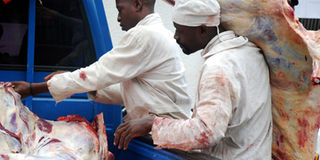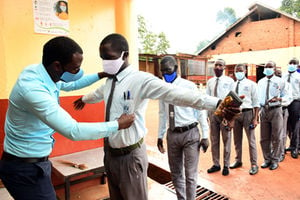Prime
Where is your meat coming from?

According to KCCA standards, meat should not be transported on people’s backs or in private vehicles that have not been approved by the Authority, and the vehicles should have covers. Photo by Edgar R. Batte
What you need to know:
Ideally, the abattoirs in the city should slaughter animals using machines, transport the meat in refrigerated cars and it should be sold n tiled butcheries. This, however, is hardly the case and it compromises the quality of the meat you eventually buy.
Health experts from the Kampala Capital City Authority (KCCA) recently sounded a warning to the public about the safety of meat they take. Emphasis was put on pork which was confirmed to be contaminated. Dr Emilio Ahimbisibwe, the KCCA senior veterinary officer, said the pork sold in the city is increasingly becoming risky for human consumption, citing the unhygienic nature in which animals are slaughtered, and how the meat is transported and prepared. He said, “A big percentage of pigs slaughtered in Kampala are not cleared for human consumption.”
But the management at the main pig slaughter house in Nalukolongo- Wambizi claim they produce good meat. “They are not yet up to the standard we want them but they are trying their best,” Dr Ahimbisibwe said in a separate interview, a message the abattoir veterinary doctor, Jane Lwanira, re-echoes.
The process is still irregular at the slaughterhouse and the vet doctor says that there is urgent need for the management to put up permanent structures as approved by KCCA. “We have tried to adhere to the minimum standards set for us by KCCA. We ask for animal permits immediately the pigs are delivered here. The vets then check their health status before they are slaughtered,” Thomas Kasule and Fred Kibuuka, managers at the four-decade old slaughterhouse, explain.
A few improvements have been made to the slaughterhouse in the last four years. A new slaughterhouse has been put in place, fitted with terrazzo at the wash points. But that is not yet enough. And it is not just pork that the public should be concerned about. The larger section of the public enjoy others meats – beef, goat and chicken whose production is also filled with challenges.
John Lule Kutyamukama, KCCA Chief Health Inspector, explains that the abattoirs authorised by KCCA to supply meat in Kampala and its suburbs are Wambizi Abattoir, in Nalukolongo for pork, Kampala City Abattoir, Nsoba Abattoir and Kishita Young Farmers Slaughterhouse, in Kalerwe for other meats. “The Kampala City Abattoir and The Meat Industry, on Old Port Bell road are the two standard abattoirs. Then there are other abattoirs in Kalerwe and in Wankulukuku that are not yet up to standard,” he adds.
A visit to Nsoba and Kishita abattoirs shows there is some construction of extension wings taking place. However, the place was muddy on the outside, compromising the hygiene inside the abattoirs. They are located within a wetland and when it rains heavily, Kishita slaughterhouse floods, which comes with a run-off of garbage from the Nsoba channel, thereby rendering the slaughter area unusable.
Standards not met
“The standards are still wanting and the managers need to be more committed to the directives of KCCA,” Dr Henry Mugerwa, the abattoir inspector of Nsoba and Kishita, explains. A letter dated October 25, 2011, addressed to Hajji Ahmed Kezaala, Kishita’s Managing Director notifying him of the suspension of activities at his abbatoir, states that KCCA public officials inspected his slaughterhouse on September, 22, 2011 and found his premises unsuitable for handling meat due to a number of reasons.
“There is no running water in the slaughterhouse. There is a poor effluent disposal system due to poor drainage as the slaughterhouse is below the level of the surrounding area that allows the highly contaminated Nsoba channel to flow inside the slaughterhouse,” the letter reads in part. It is signed by Dr Makanga LKM, the then acting Director Health Services at KCCA.
Kezaala tries to explain why: “When it rains the water floods our slaughterhouse but we are constructing another building which we are building in conformity with the KCCA standard. We shall have terrazzo on the floor and a running water system, and fitted metallic rails.”
But, he says that they are going slow on the construction given its heavy budget, a similar explanation shared by Captain Denis Aubrey Saazi, the Managing Director of Nsoba, who said he is yet to put up another modern slaughterhouse. Lule emphasises that all slaughterhouses do not meet all the standards. “The two main ones try, 70 per cent. It is not a guarantee the meat is 100 per cent safe, because it is inspected but not properly transported. Meat should be transported in refrigerated vehicles. In Uganda there are only two and they do not work properly,” Lule states.
Dr. John Musisi, the meat inspector, Kampala City Abattoir adds that the abattoir was built in 1937 according to the standards of the time. He says health standards are compromised because slaughtering takes place on the ground, which contaminates the meat with germs.
The City Abattoir however, is close to being a model abattoir where unlike the manual slaughtering at the Kampala City Abattoir, animals are slaughtered by a machine and then the meat is moved on rails and not simply carried on people’s backs like it is done at other abattoirs.
The fridges required by law at Kampala City Abattoir as Lule states are inadequate. “There is one working fridge which cannot take 700 kilogrammes yet we handle about two and half tones of meat per day,” Dr Musisi explains.
For now, the meat at the abattoir is transported in boxes which Dr Deborah Namugenyi, another veterinary doctor at the Kampala City Abattoir, says are inspected for cleanliness. However there are many cases of meat being transported on people’s backs and on boda bodas as well as private vehicles, which she says is unacceptable.
“The vehicles transporting the meat should be approved by KCCA, and then they should be covered,” Dr Namugenyi says.
Nsoba and Kishita have been faulted on some of these minimum standards. They are now heeding to pressure from KCCA, which has shut them down on several occasions as well as taken them to court only to be frustrated by “godfathers” in high political offices, Dr Ahimbisibwe says.
“People think that we are sleeping but there are factors beyond us like political influence. I’ll close a place for not meeting minimum standards and a political head will tell me to open it, so my hands are tied,” he says. He adds that it is hard for these abattoirs to try and improve on their facilities while they continue operating. Naturally, he argues, this will end up contaminating the meat. Lule discloses that on top of the hygiene standards, none of the abattoirs in Uganda has a machine which makes animals unconscious before they are slaughtered.
“Therefore slaughtering of the animals is through fighting them,” he adds. This, he says compromises the quality of the meat as it gets bruised. “We are fighting a war in Kampala to improve hygiene. We have closed many places,” Lule asserts.
And even at the City Abattoir which grapples with hygiene, Dr. Musisi says that the meat there is 90 per cent safe. “We use a lot of water to try and clean the place and rid it of blood and other waste from the animals,” he adds. Lule explains that butcheries, which are the basic points at which meat is sold to the public, need to meet certain standards.
“The meat must be transported in a hygienic way to the butchery. We expect the butchers to be clean and so should their places of operation. The butchery must have tiles on the floor and walls must be tiled and there must be water. We expect them to have glass so that flies and dust cannot get onto the meat and they must have hand-washing material. Butchers must be medically examined,” he explains.
On average, you will find this in town and few in the suburb. There are, however, many butchers in places like Kalerwe and Wankulukuku, whose butcheries are in a poor state, put together with a little wood to serve as the cutting area. Flies are always buzzing around, on and off the meat.
The flies come from the semi-permanent houses from where a strong stench comes. Residents say the channels get blocked and then the rubbish takes a while to get dry enough for burning, giving off a bad stench. What is worse is that some locals ease themselves in the channels and the flies fly off the waste and onto the meat in the butcheries.
Dr Namugenyi emphasises, “We make surprise visits to butcheries and have closed several of them.”
But many of those operating still do not meet the standards.




